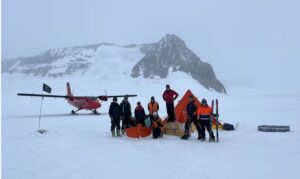James Holman (1786-1857) might just be the most prolific British adventurer you’ve never heard of. In a time when the only people to travel the world were sailors, merchants, diplomats and a few naturalists, he did something unheard of: He traveled around the world on his own, purely out of curiosity and for fun. By 1832, he had circumnavigated the globe, and by 1846, he had visited every inhabited continent. He was also completely blind.
In 1866, journalist William Jerden wrote, “no three of the most famous travelers grouped together would exceed the countries traversed by our blind countryman.” He was correct; by the time he died, Holman — nicknamed The Blind Traveler — had traveled further than anyone is known to have traveled before, an incredible 400,000km.

A young James Holman.
Born in Exeter, Holman had always dreamed of travel. At the age of 12, he enlisted in the Royal Navy and sailed the Atlantic. Over 12 years, his health began to deteriorate, he had mysterious pains in his legs and his feet and ankles became inflamed to the point where he could barely walk. He had developed severe rheumatism.
So in 1810, the now-Lieutenant was sent back to England in agony, as an invalid. His luck did not improve when he got home. His eyesight began to fail, and by the age of 25, he was completely blind.
In the early 19th century, he faced a grim future, and was expected to settle for begging on the street, with a rag tied around his eyes so he didn’t upset passersby. Instead, Holman vowed to find “some pursuit adapted to my new state of existence, a congenial field of employment and consolation.”
Dressed in his Royal Navy uniform and refusing to wear a blindfold, he began venturing outside as soon as he could. With his metal-tipped walking stick and newly developed sense of hearing, he began to explore. His next goals were to relearn to write and get a job. He did both and was soon one of seven Naval Knights of Windsor — typically disabled Lieutenants, single men without children, “inclined to lead a virtuous, studious and devout life.” He was given a small salary and a free room at Windsor Castle for life. It was dull, but it allowed him to develop his other senses and learn how to live as a blind man.
Never one to allow his lack of eyesight dictate his life, he decided he wanted an education, specifically to study medicine. He convinced the governor’s board of the Naval Knights that his plan was a good one, and off he went to Edinburgh University.
He remained there for three years before falling ill again and returning to Windsor. A doctor advised him that he needed a popular remedy of the time for obscure ailments: the sun. The plan was for his brother to accompany him on a trip to France, but on the day they were due to set off, his brother had still not been granted leave from the Navy. Holman was not about to have his trip to the healing sunshine ruined and decided to go alone.
He went in to France solo, with very little money, unable to speak a word of French and unable to see. But he loved it and wrote of his first foray into adventure “Behold me, then, in France! Surrounded by a people, to me, strange, invisible, and incomprehensible.”
Still in his naval uniform, he traveled around France for a year and became an expert in using his walking stick to navigate the unknown streets of new cities. Holman had always had a penchant for the ladies, and women quickly warmed to this perfect gentleman, despite his blindness. He couldn’t see them, so they often let him touch their faces. His twin handicaps of blindness and poverty did not make for a particularly successful marriage prospect, so he never considered it. Marriage would also have cramped his peripatetic style. So instead, he enjoyed the exotic appeal as a charming, foreign, blind man in uniform.

The Blind Traveler
Holman said that his blindness gave him “a stronger zest to curiosity”. After France, he was supposed to return home, but he couldn’t bring himself to give up his new life. So he continued on to Italy, climbed the dome of St Peters Basilica and became the first blind man to reach the summit of active Mount Vesuvius.
In Naples, he met an old navy pal, known only as Mr C. Mr C was deaf, and the bind man and the deaf man teamed up and traveled Switzerland, Germany and the Netherlands. They parted ways in Amsterdam, and Holman returned to England. Bored by the return to his life as a Naval Knight, he hired scribes to create a written record of his past 700 days. The book, given the snappy title of The Narrative of a Journey, Undertaken in the Years 1819, 1820, & 1821, Through France, Italy, Savoy, Switzerland, Parts of Germany Bordering on the Rhine, Holland, and The Netherlands, became an unlikely success. But by the time it was published, Holman had set out on his next adventure, to make “a circuit of the world”.
With very little money, he decided that the best approach was to cut down on sea travel, which was relatively expensive, and journey as much as possible overland via public transport. He came up with the insane plan of traveling across the Russian Empire, through Mongolia, sneaking into China, taking a whaling ship to the Sandwich Islands, finding any ship to take him around Cape Horn, then making his way to South America and Africa before returning to Europe via the Mediterranean.
The journey did not start smoothly. His ship to St Petersburg, the HMS Saunders Hill, almost sank in the Thames and then was detained off the Russian coats by inebriated customs officers, who demanded brandy in exchange for a passport stamp.
Despite it all, he made it to Russia and spent the winter in St Petersburg. He then traveled to Moscow, where his intentions to head further east prompted dire warnings from everyone. “The name of Siberia seemed connected in their minds only with horror,” he wrote.
His plan was to get to Irkutsk, from which he could a license to travel anywhere. He bought a wagon and horses, hired a driver and headed off into the frozen wilderness. The next 5,600km trundled across non-existent roads in the bitter cold, but after three months, Holman succeeded in reaching Irkutsk.

A Cossack fends off a weird-looking tiger in Holman’s second book, although in Irkutsk, he was still thousands of kilometres away from tiger country in the Russian Far East.
His elation was short lived, because shortly after arrival, he was arrested on suspicion of being a spy — a blind spy! — and swiftly taken back the way he had just come. In Moscow, he was put under house arrest and told he could not leave without written consent from the Tsar himself. After a few interviews with the Tsar’s secret police, he was dumped at the border and told to cross over into Poland.
As a man whom the Tsar had just expelled from Russia, he was not well-received in Poland. With no idea why all this had happened, a very confused Holman made his way home to England. Always one to make the best of his situation he decided the best way to do this was to return via Austria, Saxony, Prussia and Hanover.
This latest adventure led to a second book, with another catchy title: Travels through Russia, Siberia, Poland, Austria, Saxony Prussia, Hanover etc. It was published in 1825. Thanks to the success of his first book, he was given the honour of dedicating his second to King George VI. Unintentionally, he had become quite the literary celebrity, and now with royalties from his first book, he could attempt his round-the-world excursion by boat.

An illustration from Holman’s second book.
He sailed for Fernando Po, an island off the Western African mainland thought to be free of malaria. But fever tore through the group at breakneck speed. Of the 135 men on the ship, only 12 survived. For once, Holman had luck with his health and was one of them. He spent a year on the island helping a friend set up a base and growing a beard that he kept for the rest of his life.
He then managed to wangle his way onto a Dutch ship bound for Brazil. From here, he began the incredible sea voyages that allowed him to realize his dream to circumnavigate the globe. He went from Brazil to South Africa, Zanzibar to Mauritius to Ceylon (Sri Lanka), Calcutta and Canton (Guangzhou). From here, he sailed to Australia, then across the Pacific, round the tip of South America, back to Brazil, and home.

Holman’s circumnavigation.
To stop anyone treating him like an invalid when he boarded a new ship, he often did the same party trick: Climb up the rigging to the very top, then shout and wave to the gobsmacked men below. He was determined to explore like a man who hadn’t lost his sight and couldn’t bear people treating him otherwise.
Wherever he went, his travels were exciting and, always in his navy uniform with his trusty walking stick, he said yes to every opportunity. In Brazil, he explored gold mines, in South Africa he taught himself to ride a horse and ventured into the wild with a young sidekick who spoke no English. After being warned of great unrest in Madagascar, he immediately headed for the island. He crossed Zanzibar and Tasmania on foot, took part in an elephant hunt in Ceylon and tried an opium pipe and to learn Cantonese in China. For the five years he was away, he relied on “divine protection and on the sympathies of mankind”.
Although Australia, the final destination of his circumnavigation, treated him like a celebrity, he knew the time had come to go home. He was pushing his luck with the Naval Knights and the stipend they gave him. At home, he wrote a third wide-ranging book, A Voyage Round the World, Including Travels in Africa, Asia, Australasia, America, etc. Although Charles Darwin eventually used it as reference material, it was not well-received. The once-inspirational figure had become a bit of a joke.

James Holman in 1849
He stayed at home for eight years before deciding to travel again. In 1840, at the age of 54, Holman set off for the Mediterranean and Middle East. For the next six years, he visited Spain, Portugal, Greece, Turkey, Syria and the Holy Land. He cut through Libya, Tunisia and Egypt, and went up into Bosnia, Montenegro and Hungary.
He returned to England out of necessity: He was destitute, all his royalties spent. Although respected and loved by his peers, he had been largely forgotten. No one was interested in publishing the book of his final, epic journey. The idea of reading a travel book by a blind man now seemed ridiculous, and people questioned how accurate his record of these places could be.
He lived out his years in east London, down by the docks, and put all his energy into compiling his memoirs. He began to see them as a race against death. He completed his manuscript, Holman’s Narratives of his Travels, a week before he died. Though his friend Robert Bell tried to get both his memoir and his third travel book picked up by a publisher, no one was interested in the stories of the most traveled man in the world.The manuscripts were eventually lost.






